Palmer Octobus – Loop Switcher for effects pedals – A Bonedo.de Test Report
The Palmer Octobus in the bonedo test Marathon – The German manufacturer Palmer enters our testing marathon for effects pedal loopers. The boys from Hessen tend to focus on the essential in terms of design, there are no fancy special functions such as amp-switches or MIDI controls, but a simple program: eight loops can be equipped with effects devices and their combinations can be saved on 32 presets.

In addition, the device does not take up a lot of space on the pedalboard and is priced at just under 200 euros, therefore in the lower end. In this regard, it is a good choice for guitarists who simply don’t want to tap dance with eight pedals and do not care about special functions. But what abut the key factor – sound quality?
Details
Housing/Looks The Octobus comes in a massive, sturdy steel sheet case, that hardly takes up any room due to its eleven centimetre depth. The bottom plate and the sides are a little deeper and offer two holes for mounting onto a pedalboard, as well as protection for protruding plugs. All control elements are on the top side, the connectors on the back panel.
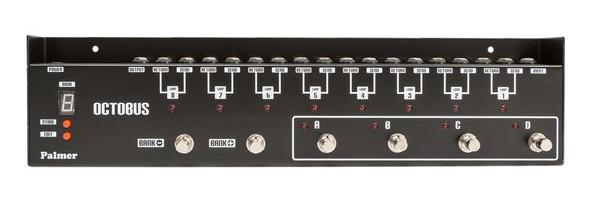
The device is equipped with six switches on the bottom row, with just enough distance between them to avoid double-circuits. On the left side, you will find the display for showing the memory bank and two switches to edit. For further viewing of the memory slots, there are small red LEDs next to the switches A to D; the active loops are also indicated by bright LEDs.

Rear Panel / Connections
Eight loops on the rear panel each provide a Send and a Return socket. The 16 connections are flanked by the input and output socket, all of course in the 6.3 mm jack format. On the far right, is the connection for the supplied mains plug and that is all. The Octobus is equipped quite simply, there are no stereo loops, no switchable buffer, no amp switching or MIDI functions. Instead, there are eight loops and operating it is very simple.
Operation 32 memory slots are available, divided into eight banks, that can be adjusted using the Bank+ and Bank- switches. The respective bank is shown as a number on the display. Per bank, there are four memory slots, which can be selected with the buttons A, B, C and D.
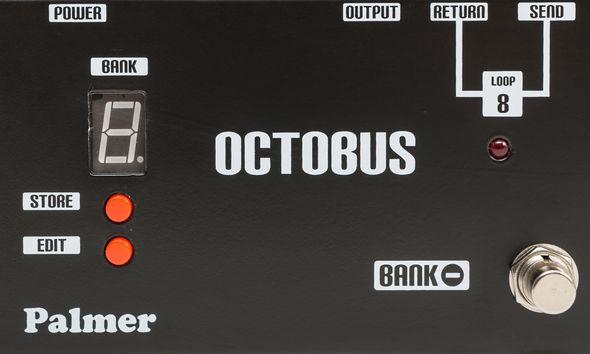
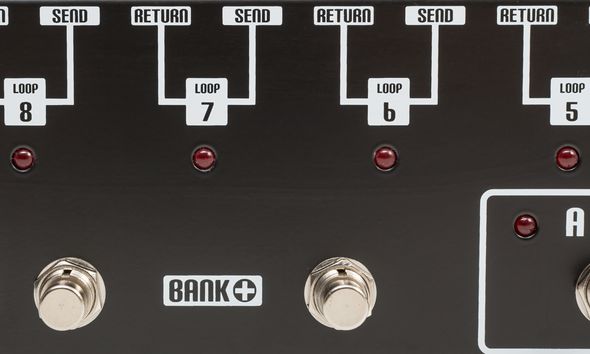
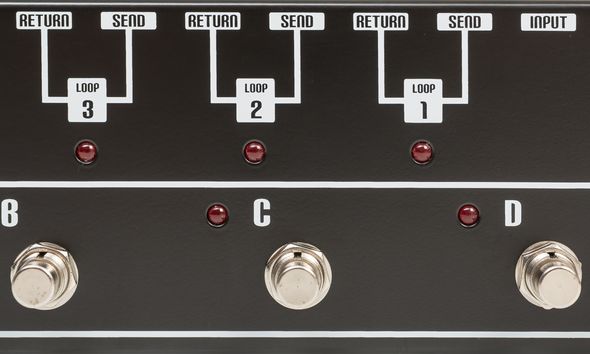
To program the loops, the Edit button under the display must be pressed. Now you can switch the first four loops on or off using the buttons A to D, ‘L’ is shown on the display (Lower Loops). Loops five to eight are enabled when the Bank+ switch is pressed, then ‘H’ is shown on the display (Higher Loops). Now all the desired loops are activated and you simply need to press store to save the combination in the selected memory slot.
If you want to switch all the effects directly onto bypass, there is no need for improvising with an additional preset: simply press the switch of the selected memory again. At this moment, all the loops will be deactivated and the input signal will be sent directly to the output.
Practice In the practical part, we conclude by once again taking a brief look at the sound and signal fidelity that is so immensely important for this type of equipment. For this purpose, various interconnections will be scrutinised. Since the sound differences tend to be in the microscopic range, you need to listen to the whole thing through good speakers or headphones so that you can pick up changes at all. Notebook speakers are not necessarily the first choice.
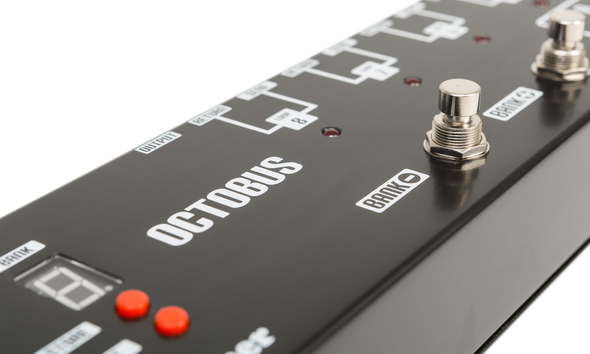
First up is the reference signal, the direct connection between the amp and the guitar using a Les Paul and a Marshall Plexi. The amplifier is set to Mid Gain, where you can make out differences in volume levels more easily by changing the distortion level. Also, it is here that the amp responds very clearly to the incoming signals. At the start of the test, I strum lightly with my fingers, then hard with a pick.
A normal mixture of effects pedals is then used, three of which have a True Bypass, and these pedals (of course with high-quality cables) are connected directly to the amplifier, however, no effect is enabled. I would like to explore the signal loss which occurs with this combination, when all effects are turned off. Here is the setup; the True Bypass pedals are marked with ‘TB’: Analogman Astro Fuzz (TB), Boss OD-3, AMT E-Drive (TB), Boss CE-5, TC Electronic Flashback (TB)
Now the signal with the Octobus installed in between. Loops are not activated, which is exactly the same as when effects are in the switched-off position. The signal is sent directly from the input to the output, and should in any case be better than the effects chain in the bypass.
This is indeed the case, however, there is a clear difference with the direct signal. It sounds a little duller in the high range, but with a greater accumulation of effects pedals, it is definitely worth having the Octobus in play for acoustic reasons.
Click here for the audio samples: http://www.bonedo.de/artikel/einzelansicht/palmer-octobus-test/2.html
Conclusion
The Palmer Octobus is simple and straightforward and provides eight loops whose combinations can be saved in 32 presets.. The operation is very simple, the device does not take up too much space on the pedal board, is rugged and deserves the "road-friendly" label. However, it could become somewhat critical for long cable runs with the True Bypass circuit, the loss in the highs is in any case stronger than on the loop switchers with switchable buffer amp.
Pros
+ Simple Operation
+ Sturdy Design
+ 32 Presets
Cons
– no buffer (loss in the highs for longer cable runs)

Specifications
Manufacturer: Palmer
Model: Octobus
Type: Loop switch for effects pedal
Loops: 8
Connections: 8 x Send/Return, Input, Output
Switch: A, B, C, D, Bank+, Bank-
Power Consumption: 300 mA
Voltage: 9 V
Display: one digit
Memory: 32 Presets
MIDI: no
Dimensions: 455 x 110 x 45 mm (W x D x H)
Weight: 2.2 kg
Price: € 198 (RRP)
____________________________________
Source: Bonedo.de:
http://www.bonedo.de/artikel/einzelansicht/palmer-octobus-test.html
Author: Thomas Dill
Complete product information is available here:
http://www.palmer-germany.com/mi/en/OCTOBUS-8-channel-Programmable-Loop-Switcher-PEOCT.htm
Leave a Comment
You must be logged in to post a comment.












